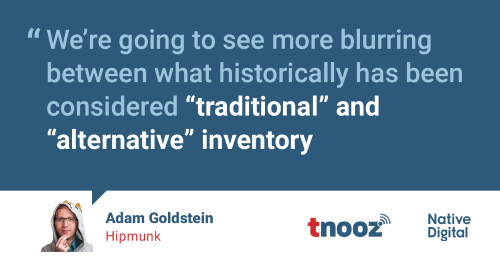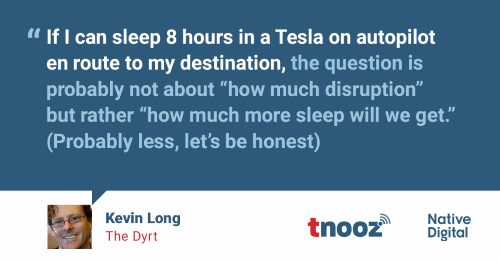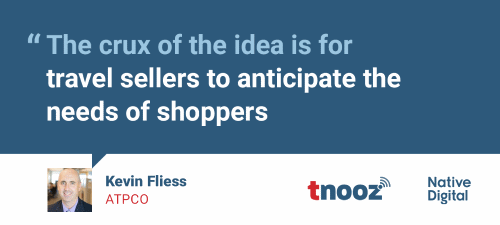
Tomorrow’s traveler – Hipmunk, The Dyrt and ATPCO share their views
By cameron in Uncategorized
This is a viewpoint interview series by Justin Watkins, Creative Strategist at Native Digital
As changes in technology and consumer culture create waves across the wider ecommerce marketplace, the travel and tourism industry is certainly not immune to impending disruption. In the face of industry-wide transformation, leaders must shift their focus from asking “what’s happened?” to asking “what will happen in the future?”
In this Q&A series we hear a variety of perspectives and pro tips on how the industry is modernizing to meet the expectations of a new age of travelers.
This week’s guests:
Adam Goldstein, CEO, Hipmunk
Kevin Long, CEO and cofounder, The Dyrt
Kevin Fliess, Vice President, Marketing and Sales, ATPCO
Q: What new travel technologies are you betting will be mainstream within 5 years? Which are a long way from primetime?
ADAM GOLDSTEIN: As the builders of the first and one of the most popular consumer travel chatbots in the industry, we’ve seen the increased desire to have AI-powered digital travel assistants for both consumer and business travel planning. In fact, when SAP Concur built the Concur Expense bot on Slack, more than 100 teams installed the application within the first 10 hours of its release.
Thanks to the success of the Concur Expense bot adoption, Hipmunk recently helped introduce the Concur Travel bot on Slack, available in beta to joint Concur Travel and Slack customers that enables Concur Travel bookings directly in Slack.
KEVIN LONG: I remember in the year 2000 they said flying cars would hit the streets by 2010. Answering this question in 2018, having never seen a flying car, I am going to put my money on travel companies using technology to create new experiences.
Social media has ballooned on Facebook, and now we’re seeing it fracture into niche communities. Travelers are able to self-select into the communities and get real, targeted value to improve their travels. For instance, seekers of ‘the road less traveled’ can now join and participate with Atlas Obscura. Campers who want to dig into local knowledge of campsites and relevant gear can join and engage with thedyrt.com. It is an incredible time for niche communities.
KEVIN FLIESS: Over the next five years expect to see NDC, dynamic pricing, and rich content become mainstream in flight shopping. These three technologies taken together will open up a new universe of dynamic offer creation, whereby airlines will be able to create curated offers that combine the perfect price with rich content — and then deliver those offers out to their distribution partners through direct connects. This approach of dynamic offer creation should lead to a better shopping experience for consumers and higher conversion for airlines and sellers alike.
Do you see the purpose of leisure trips evolving? i.e. to volunteer, gain social capital, or immerse in local culture?
KEVIN LONG: Yes and no. The purposes we tell ourselves for travel might change, but the root motivation is always going to be the same: we are curious, we want to do something significant, we are interested by the unknown. The catalyst for these motivations is definitely impact by technology.
For instance, it goes without saying that social media encourages travel for its own sake. Visual platforms by nature cannot convey the complexity of human experience, and travel is no exception.
Thus, shallow caricatures of what we want travel to mean – what we are motivated by when we want to travel – are elevated and celebrated. This will increase and decrease over time. But just like waves in the far-off oceans we visit, the surface changes but the depths remain.
What types of traveler personalization, do you think we’ll see more of very soon?
ADAM GOLDSTEIN: Every traveler has their own preferences, and those preferences can change depending on what type of travel in which they are engaged. For instance, your needs when taking a family vacation are far different than when traveling on business. Hipmunk took a big step in this direction with our recent flight search redesign, which shows travelers exactly what’s available on each flight, directly in their results. It also shows travelers how those options change based on the fare type they book.
The new experience makes it easy for travelers to quickly compare flights by what matters most to them, whether that’s the miles they’ll earn, extra legroom, WiFi availability, or whether they’ll be charged for a carry-on.
Also, we think personalization based on calendar information is essential for business travelers—it’s why we’ve incorporated this into our site and our bot.
KEVIN LONG: Machine learning will impact destination travel in a big way. Think Netflix Suggestions, except instead of movies it’s trips. This requires the sophistication of one conglomerate or network that controls both engaging content (generating data points for user affinity categories) and also trip inventories (suggesting and monetizing user affinities).
KEVIN FLIESS: Today, travel planning is highly reactive and, at times, tedious. I shop, compare, shop some more, compare some more, abandon my cart, and maybe, eventually buy. There’s a real opportunity for proactive personalization here.
For example, if I always go visit my in-laws in Fort Myers, FL every year at Christmas, a smart booking engine that anticipates my needs and recognizes my travel habits, could proactively start recommending itineraries and monitoring fares for me months in advance.
If my Outlook calendar shows a conference coming up in October in Paris, the same engine could start shopping for flights well in advance and recommend preferred hotels within walking distance of the event location.
Layer in machine learning and the system could start to anticipate experiences and itineraries that I haven’t fully contemplated yet but that match my evolving tastes and interests.
Between transportation and accommodations, which do you think will see more industry disruption in coming years?
ADAM GOLDSTEIN: In terms of industry disruption, I think we’re going to see more blurring between what historically has been considered “traditional” and “alternative” inventory. We’re going to see more consumerization of business travel, such as with Concur Hipmunk, where travelers will have access to all different types of transportation (trains, Lyfts, scooters) and accommodations (vacation rentals) based on their personal preferences and regardless of the type of travel.
KEVIN LONG: Neither, because we’ll start to see them combine. If I can sleep 8 hours in a Tesla on autopilot en route to my destination, the question is probably not about “how much disruption” but rather “how much more sleep will we get.” (Probably less, to be honest.)
Big or small, what’s the biggest pain point with travel waiting to be solved?
ADAM GOLDSTEIN: As the types of flight fares and amenity options increase, it’s becoming more difficult to present information to consumers in language that is clear while still being concise. The challenge for the industry will be to create an enjoyable low-cost experience, wherein travelers know exactly what to expect for every given price point.
KEVIN LONG: We know about the Santorinis and Madrids of the world. The biggest pain point in travel is not knowing about the destinations in your backyard. Online communities will surface these sunken treasures to make the offline travel experience all the more regular.
KEVIN FLIESS: Trip planning is still tedious. With AI and machine learning, smart booking engines will emerge that anticipate my travel needs. The crux of the idea is for travel sellers to anticipate the needs of shoppers by looking at historical buying habits, real-time signals, and future events. The whole idea is to deliver convenience in the form of relevant and timely offers that I need, which meet my budget, and eventually surprise and delight.
Key Takeaways:
- Look for emerging technologies such as AI and machine learning to become an integral element of the travel planning process.
- The next-gen travel planning experience aims to consolidate and eliminate unnecessary touch-points; travelers will enjoy seamless planning that anticipates their personal needs.
- Greater access to relevant information will remain a primary objective. Meeting and exceeding the customer’s evolving expectations will require more than just tech-enabled solutions.
- Disruption is inevitable for both transportation and accommodations. As lines begin to blur between ‘traditional’ and ‘alternative’ options, new growth opportunities will emerge for brands willing to bet on non-traditional solutions.
This is a viewpoint interview series by Justin Watkins, Creative Strategist at Native Digital
Opinions and views expressed by all guest contributors do not necessarily reflect those of tnooz, its writers, or its partners.
![]()




